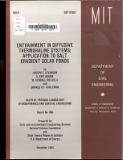Entrainment in Diffusive Thermohaline Systems: Application to Salt Gradient Solar Ponds
Author(s)
Atkinson, Joseph F.; Adams, E. Eric; Melville, W. Kendall; Harleman, Donald R. F.
Download13492421.pdf (13.25Mb)
Metadata
Show full item recordAbstract
The development of a numerical model for simulating the temporal evolution of vertical temperature and salinity profiles in a salt gradient solar pond is described. The model uses a mixed-layer approach and a general entrainment relation is derived for predicting the growth of the upper mixed layer. A major part of the research involves an experimental study of the process of mixed-layer deepening in a strongly stratified "diffusive" double-diffusive system. Two different experiments are described. In the first, a vertically oscillating grid was used to drive interfacial mixing in a two-layer system in which the temperature and salinity differences between the layers were varied over a large range of values. Results for single stratification (temperature or salinity) were found to agree with those of earlier researchers, but it was found that for a given ... where g = reduced gravity ... are turbulence length and velocity scale, respectively, an increase in the destabilizing temperature difference would cause an increase in the rate of entrainment over the value for salinity stratification alone. This effect is modeled by defining a velocity scale which includes the buoyancy-induced velocity resulting from the temperature distribution. The second experiment looked at wind-induced mixing in a laboratory wind/wave tank. Tests were done using several different mean wind speeds ranging from 4 m/s to 11 m/s. Two-layer systems were again considered, with either salt or diffusive double-diffusive stratification. Two separate fetch lengths were also considered in an attempt to find a fetch dependence on the entrainment rates. No differences could be seen in the results for the two different kinds of stratification, with the entrainment rate following roughly an inverse Richardson number law. However, the mixed layer deepening was somewhat faster for the longer fetch and this result is explained in terms of an increased return flow along the interface, leading to increased shear-induced mixing. A series of experiments was also conducted in the wind/wave tank to test the effect of placing floating plastic netting or floating plastic pipes on the water surface. This has been suggested as a possible means of helping to reduce wind-induced mixing in solar ponds. The results obtained here indicate that both the nets and pipes can be at least partially effective in reducing wind-mixing, with the nets generally performing better than the pipes. Some increased mixing may be present directly beneath a floating net or pipe, but the a really averaged effect of the nets or pipes is to decrease the turbulence levels in the surface water layer. Experimental data, along with suggested values obtained from previous researchers, are used to define suggested values for the coefficients in the entrainment model which is incorporated into the full numerical simulation model. Sensitivity of the model to several of the parameters is examined and a calibration run is shown, using field data from a small solar pond. Unfortunately, wind-mixing was apparently not very important in this pond and a full calibration test of the wind-mixing model will have to wait until data from a much larger pond becomes available.
Description
The research reported here has been supported by the Department of Energy, through the Solar Energy Research Institute subcontract no. XX-3-03066-1. The research reported here has been supported by the National Science Foundation, grant no. CEE-8119384.
Date issued
1984-12Publisher
Cambridge, MA. : Ralph M. Parsons Laboratory, Hydrology and Water Resource Systems, Massachusetts Institute of Technology, Dept. of Civil Engineering
Other identifiers
300
Series/Report no.
R (Massachusetts Institute of Technology. Department of Civil Engineering) ; 85-5.Report (Ralph M. Parsons Laboratory for Water Resources and Hydrodynamics) ; 300.